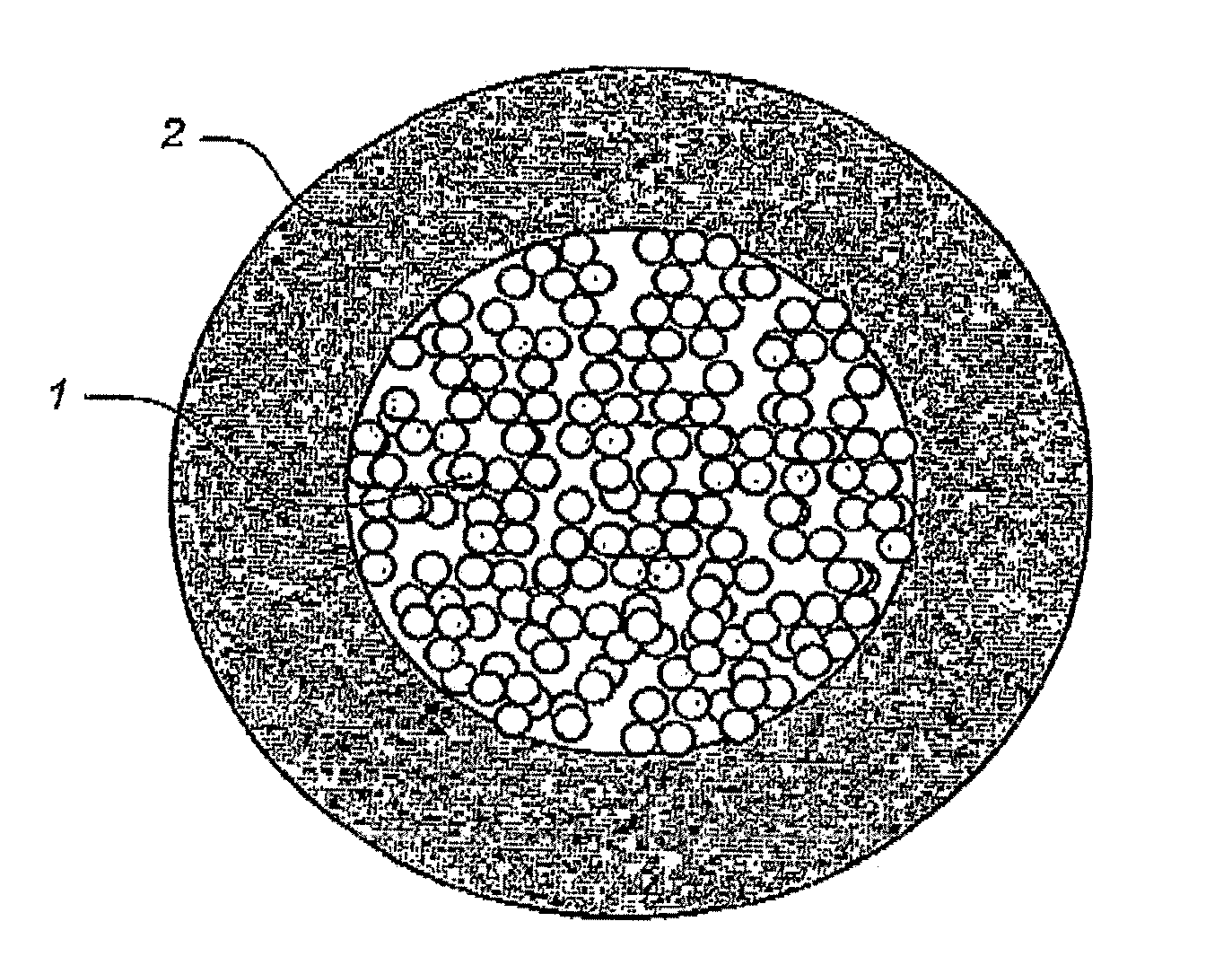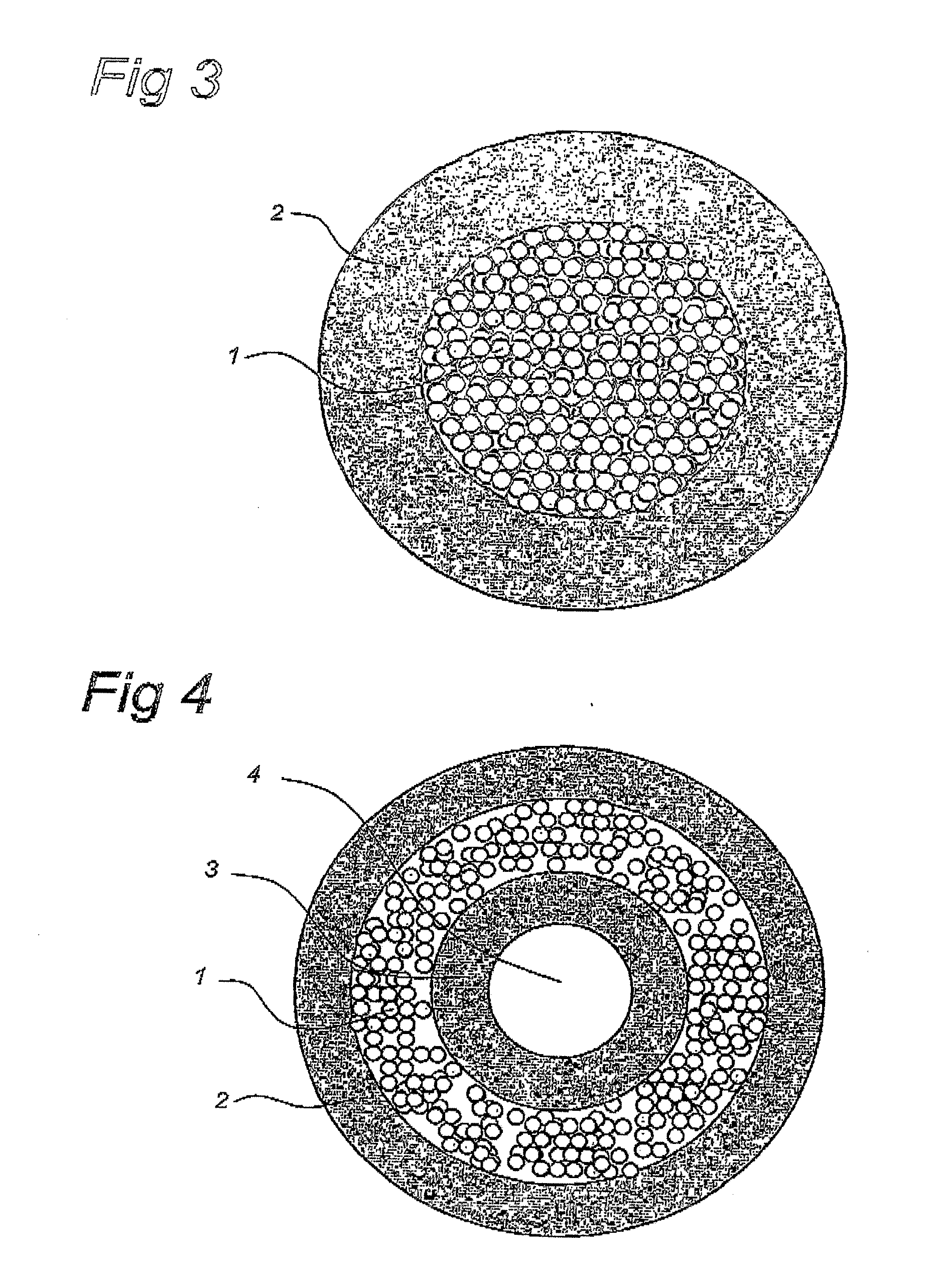Functional Porous Multilayer Fibre and its Preparation
a multi-layer fibre, porous technology, applied in the field of hollow or solid fibres, can solve the problems of limited degree of loading of particulate materials, limited polymeric materials and on the type of particulate materials that can be used, and dense exterior surfaces, etc., to achieve enhanced mechanical stability, maximum functionality, and improved mechanical stability
- Summary
- Abstract
- Description
- Claims
- Application Information
AI Technical Summary
Benefits of technology
Problems solved by technology
Method used
Image
Examples
example 1
[0060] A homogeneous polymer solution 1 with the following composition was prepared by ring 9.5 wt % polyethersulfon (Ultrason E 6020 P), 24 wt % polyethylene glycol 400, 4.5 wt % PVP, 6.8 wt % dry Sepharose FF (34 μm), 6 wt % water and 49.2 wt % N-Methyl Pyrrolidone (NMP). In addition, a homogeneous polymer solution 2 with following composition was prepared by mixing 16 wt % polyethersulfon (Ultrason E 6020 P), 38.75 wt % polyethylene glycol 400, 38.75 wt % N-Methyl Pyrrolidone and 6.5 wt % water.
[0061] Both solutions were extruded simultaneously through a tube-in-orifice spinneret with the following dimensions: ID tube=0.4 mm, OD tube=0.6 mm, ID mm orifice=1.2 mm. Solution 1 was extruded at a flow rate of 5.1 ml / min through the tube of the spinneret and solution 2 was extruded at a flow rate of 0.51 ml / min through the orifice of the spinneret. After passing an air gap of 45 mm the double layer nascent fibre entered a water bath where phase separation took place. All solutions wer...
example 2
[0065] The same solutions as defined in example 1 were extruded simultaneously through a tube-in-orifice spinneret with the following dimensions: ID tube=0.4 mm, OD tube=0.6, ID mm orifice=1.2 mm. Solution 2 was extruded with a flow rate of 5.1 ml / min through the tube of the spinneret and solution 1 was extruded at a flow rate of 0.51 ml / min through the orifice of the spinneret. After passing an air gap of 45 mm the double layer nascent fibre entered a water bath where phase separation took place.
[0066] This resulted in a double layer fibre with the core layer being layer 2 (no Sepharose particles) and the outer layer being layer 1 (with 40 wt % Sepharose particles based on the total weight of layer 1).
example 3
[0067] A homogeneous polymer solution 3 with the following composition was prepared: 15 wt % Bionate® 80A (polycarbonate based polyurethane from The Polymer Technology Group Inc.), 2 wt % PVP K90 and 83 wt % N-Methyl Pyrrolidone (NMP).
[0068] Solution 1 from example 1 and solution 3 were extruded simultaneously through a tube-in-orifice spinneret with the following dimensions: ID tube=0.4 mm, OD tube=0.6 mm, ID mm orifice=1.2 mm, Solution 1 was extruded with a flow rate of 5.1 ml / min through the tube of the spinneret and solution 3 was extruded at a flow rate of 0.51 ml / mm through the orifice of the spinneret. After passing an air gap of 45 mm the double layer nascent fibre entered a water bath where phase separation took place. All solutions were at room temperature.
[0069] This resulted in a double layer fibre similar to the one presented in FIG. 5 (prepared according to example 1) with a highly porous core layer (layer 1) containing Sepharose particles entrapped and a layer 2 at ...
PUM
| Property | Measurement | Unit |
|---|---|---|
| wt % | aaaaa | aaaaa |
| wt % | aaaaa | aaaaa |
| wt % | aaaaa | aaaaa |
Abstract
Description
Claims
Application Information
 Login to View More
Login to View More - R&D
- Intellectual Property
- Life Sciences
- Materials
- Tech Scout
- Unparalleled Data Quality
- Higher Quality Content
- 60% Fewer Hallucinations
Browse by: Latest US Patents, China's latest patents, Technical Efficacy Thesaurus, Application Domain, Technology Topic, Popular Technical Reports.
© 2025 PatSnap. All rights reserved.Legal|Privacy policy|Modern Slavery Act Transparency Statement|Sitemap|About US| Contact US: help@patsnap.com



